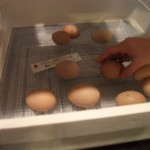What do you call a city of 20 million eggs? New Yolk City
We are on Day 13 of our annual home “egg to chick” project. It’s so easy to do, plus your local 4H chapter will help you find proper homes for the chicks; we keep ours. Eggs are turned 2-3 times daily. The penciled “o” on the single egg picture marks the egg to ensure all eggs are turned each time. One side has an x while the opposite side has an o. I hope to incorporate this activity every year in my class. We buy a dozen fertilized eggs online for approximately $4. In the past, we borrowed an incubator from our county agricultural extension center. This year we bit the bullet and purchased one. It coordinates well with many science concepts and processes. It’s an exciting project for the children and teacher too!
A Side Note
This calls to mind something I read in Teach Like a Champion, a book I highly recommend. At the beginning of chapter 2, Lemov suggests teachers need to teach with a “Begin with the End” in mind, the concept being to tailor lesson plans to objectives rather than vice versa. I agree with this, however feel there are special lesson plans that are meaty, flexible, or worthy enough to incorporate as long as one primarily teaches according to objectives first. As an example, the egg to chick project naturally coordinates with many elementary science concepts (living or nonliving, classification, adaptation, basic needs, environmental factors) or the project could simply incorporate scientific investigation objectives to encourage the wonder of life/learning. Wanting to use an exceptional lesson plan doesn’t have to mean one is trying to push the square peg into the round hole when handled appropriately. Always the safety and needs of the animals are met; we have local ranches willing to take the chicks where they live their lives happily as free range chickens.
Here are some helpful links:
Lancaster County 4H chick project
Sarasota County 4H chick project



